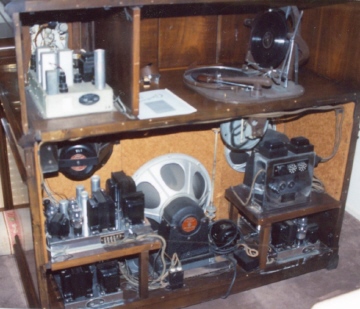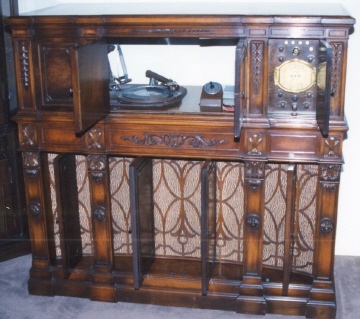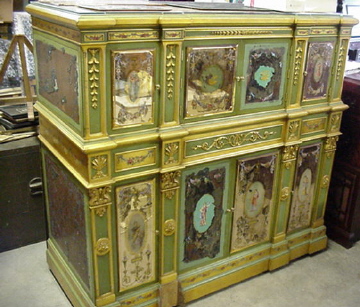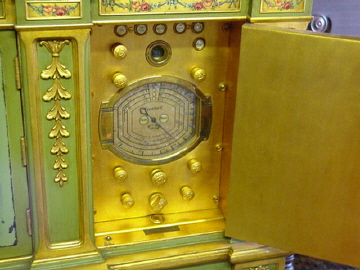The Capehart 500
Ultra-Luxury changer
Even though the country was in the middle of the Great
Depression, Homer Capehart's sales strategy of providing the
ultimate in entertainment to the well-heeled paid off.
From 1937 to 1942, the
Capehart 500 line of models represented the most expensive
standard-manufacture phonograph ever produced:
The Capehart 500 of
impressive cabinet size, would not be dwarfed in the great
hall of an East Coast or Hollywood mansion, and three
separate amplifiers, and 12", 14" and 18" electrodynamic
speakers provided the power to fill the largest space.

At a sales price for a "plain"
500 of $ 2,500, the additional remote function and custom
installations could easily top $ 5,000.
For comparison, $5,000 in the
late 30s could buy a very nice house in the major
metropolitan areas.
Movie Sightings
1939 INTERMEZZO with
Leslie Howard and Ingrid Bergman
This remake of the 1936 Swedish
original features a gigantic Capehart 500 in Leslie Howard
as Star Violinist Holger Brandt's home. His daughter is
playing a record of "Intermezzo" (beautifully recorded by
Toscha Seidel, available on a 10" Victor) repeatedly on this
machine, and it rather poignant when at she turns around and
says: "We will need a new copy. This one is worn out."
The
Capehart 500 Empire Style
The more common cabinet style for the 500 model is the
"French Renaissance" mahogany Empire style. Note the large
louvered doors that cover the three large loudspeakers.

The Capehart 501
Spanish Style
Sold to the more rustic,
mission-style homes on the West Coast, the 501 Oak Spanish
Style cabinet features a more restrained use of decorative
molding.
The Capehart 500 - The
"Painted Gypsy Funeral Wagon"
This unique example of the Capehart 500 was recently saved,
literally, from the wrecking ball.
Affectionately known to
collectors on the East Coast as the "Gypsy Wagon", this
extraordinary Capehart 500 was custom painted with rococo
motifs, and all flat panels on the cabinet were covered with
reverse-painted mirrors. Even the grille cloth was painted
with bucolic scenes.


As always I am very
interested in hearing from you.
Contact me at: sgimips1 "at" yahoo
"dot" com
And thanks so much to the excellent electronic restorer
Chuck, by whose gracious help I am able to publish these
pages.
ALSO: After having my 1946 Capehart for 2 years, I feel
like upgrading to a '48 model.
If you ever see a Capehart with a chrome tone arm and a
silver head shell on Ebay or in a local antiques store,
please send me an email. I will be eternally indebted to
you.
Again my great
thanks to Chuck for his great help in creating these pages.
Pleases check out his other web pages with even more
fascinating early audio and TV tube electronics. One level
above this page, you can find more fascinating changers with
video clips.
My thank also to Robert Baumbach who provided many
pictures, and many other people that always helped with
their advice and expertise to make these fascinating
machines run again as reliably and beautifully as the day
when they were bought.
|

